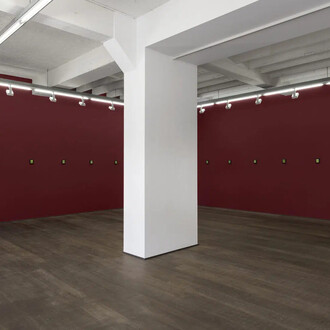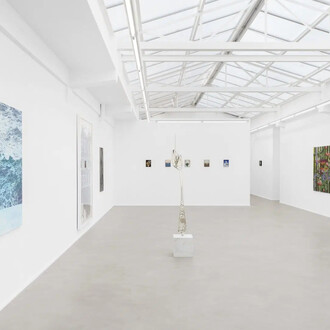MLF l Marie-Laure Fleisch is pleased to announce Giuseppe Stampone’s new solo show, The Three Graces. With creations ranging from videos to multimedia installations, Stampone offers us a selection of his singular drawings made with Bic pens, which are at the heart of his practice. As precise and meticulous as he has always been, the obvious critique about current moments of our history have left room for more personal narratives.
From album covers reinterpretations to the incorporation of migrants in classical paintings, the artist communicates his activism by associating well-known contemporary images to subtle references from art history. Thus, the artist’s critical thinking finds a universal perspective, extricating itself from the communitarianism that tends to win ideologies these days. In addition, Stampone always paid particular attention to the use of traditional techniques associated with art. The artist considers his exceptionally long creative process as a protest against the constant frenzy imposed by our century.
Made during COVID times, this newest body of works invites us to the quiet meditation motivated by the exclusive representation of architectural interiors, inspired by Dutch painters such as Vermeer and Pieter de Hooch. Houses are one of those few places where one can find refuge from the constant and mostly-confusing news feed. Represented in almost all of the exhibited drawings, the artist often drawn from behind, with a contemplative posture. Indeed, like for the most of us, Stampone had to stay confined for the past year. This sudden and unwanted change in habits led the artist to completely call himself into questions, while in the process, turned him toward the great masters of art history, searching for his answers.
The exhibition takes its title from one of Stampone’s drawings but is also a tribute to the painting of Raphael. Inspired by the classical antiquity, the three women in the original work could represent stages of development of womanhood but they are often considered as muses, symbol of human creativity. Stampone recreates the trio on an autobiographical perspective, representing himself in his childhood, his youth and nowadays, thus creating his own mythology. Perhaps these works are a proposition for us all to take a step back; to pause long enough in order to contemplate the field of possibilities and discover what we would like to see emerging from it, once this period of doubt will be behind us.
For her first collaboration with MLF l Marie-Laure Fleisch, Hanane El Farissi proposes the solo project In the Way of Transmuting. Graduated from the HISK, her sculptural work, installations and performances start from objects and everyday gestures. Individual development, what defines them and memory are the driving forces of her artistic approach. Through diverse mediums, she uses stereotypes and methods of representation, as well as trivial or anecdotal depictions, to question the values that define our contemporary way of thinking.
Hanane El Farissi’s practice may be seen as an endlessly exploration. Inspired by the most ordinary details surrounding us, the artist extracts evidences of human violence. This research, based on daily life but also influenced by Art History, aims to reveal our identity and our past. It takes place through the distortion of existing objects, giving birth to hybrid artworks with multiple meanings. Thus, these creations convey a story, both contemporary and historical, but also an ambiguity. This ambivalence in El Farissi’s work highlights contradictions in order to help ourselves thinking about our societies.
In her drawings made with diluted backgrounds, blue pen and gold leaf details, El Farissi often draws portions of architectures. Playing with different temporalities when she carries out her iconographic researches, the artist seeks for traumas humankind has been through in history, the ones which have transformed our cities. The innocent aspect of the works actually represents past events when human intervention has always something to do with madness, and shows how it permanently impacted our present. This multilayered representation gives us look at violence, its mechanisms as well as its representation through time.
A second body of works consists of sculptures representing books. Made in lead and gold leaf, the artist refers to the philosopher’s stone which transforms base metals - here coupled with drawings and poetry - into gold. Oscillating between word, image and matter, the artist wishes to uproot the initial concept in order to give it a form of spirituality and a new reasoning. El Farissi’s representation of brutality is made with delicacy and sensibility, just like the fine blue lines, almost trembling, of her drawings. The intention is not to demonstrate the violence of our species - this is no longer to prove – but rather trying to understand how to rebuild ourselves from our ruins.
















